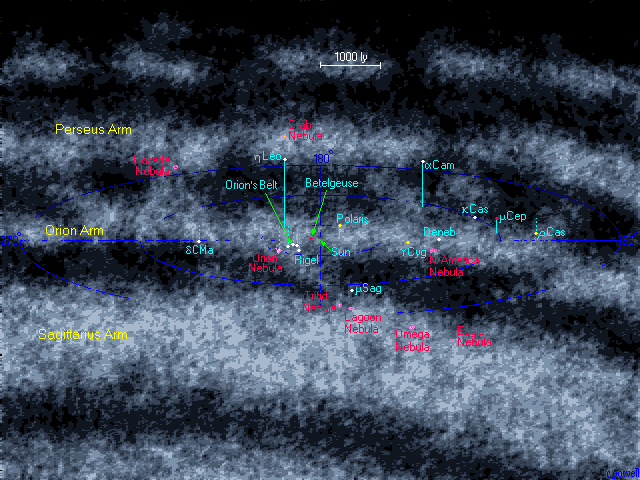| The Heart and Soul Nebulae |
|---|
 |
Located in the Perseus Arm of the Galaxy, the Heart and Soul Nebulae are
located in a region of active star formation containing many young clusters
of stars. |
| The California Nebula |
|---|
 |
This is a bright emission nebula which supposedly looks like the shape of
the state of California (but is about 1 trillion times longer). This nebula
glows because of the intense radiation from the star Xi Persei. |
| The Orion Nebula |
|---|
 |
This is probably the most famous nebula in the sky - it can be dimly seen
with the naked eye, and can be viewed from any latitude on Earth except the
North Pole. The Orion nebula lies in the middle of an intense region of
star formation. |
| The Rosette Nebula |
|---|
 |
The Rosette nebula is a circular nebula surrounding a young star cluster. The
intense radiation from the young stars has cleared a hole in the centre of
the nebula. |
| The Cone Nebula |
|---|
 |
This is another nebula surrouding a young cluster of stars including the
fifth magnitude variable star S Monocerotis. Nearby is a dark cone-shaped
lane of dust which gives this nebula its name. |
| The Eta Carinae Nebula |
|---|
 |
This is a bright nebula in southern hemisphere skies which can be glimpsed with
the naked eye. The Eta Carinae nebula is a massive region of star formation
in the Sagittarius arm of the Galaxy, and it surrounds the extremly massive
star Eta Carinae. |
| NGC 3576, 3579, 3581, 3582, 3584 and 3586 |
|---|
 |
Although it has six separate catalogue numbers, this is in fact a single
nebula in the Sagittarius arm and another region of star formation. |
| The Lagoon and Trifid Nebulae |
|---|
 |
These are two bright nebulae in the Sagittarius Arm of the Galaxy. The Lagoon
nebula is one of the brightest nebulae in the sky and it can be seen with
the naked eye. The Trifid nebula is close to the Lagoon nebula although it
is slightly smaller and dimmer. |
| The Eagle and Omega Nebulae |
|---|
 |
The Eagle and Omega nebulae are another pair of bright nebulae in the
Sagittarius Arm where many stars are being born. The Hubble Space telescope
photographed the Eagle nebula in 1995 and produced one of the most famous
astronomy pictures of recent times. |
| The Gamma Cygni Nebula |
|---|
 |
This is a faint but extensive nebula which can be found in the middle of the
constellation of Cygnus. This region of the sky looks directly down Orion Arm
of our Galaxy and there are a lot of nebulae in and around this region. |
| The North America and Pelican Nebulae |
|---|
 |
These two nebulae in Cygnus are the brightest part of a very complex region
of nebulae in Cygnus lying about 2000 light years away in the Orion Arm of
the Galaxy. |











